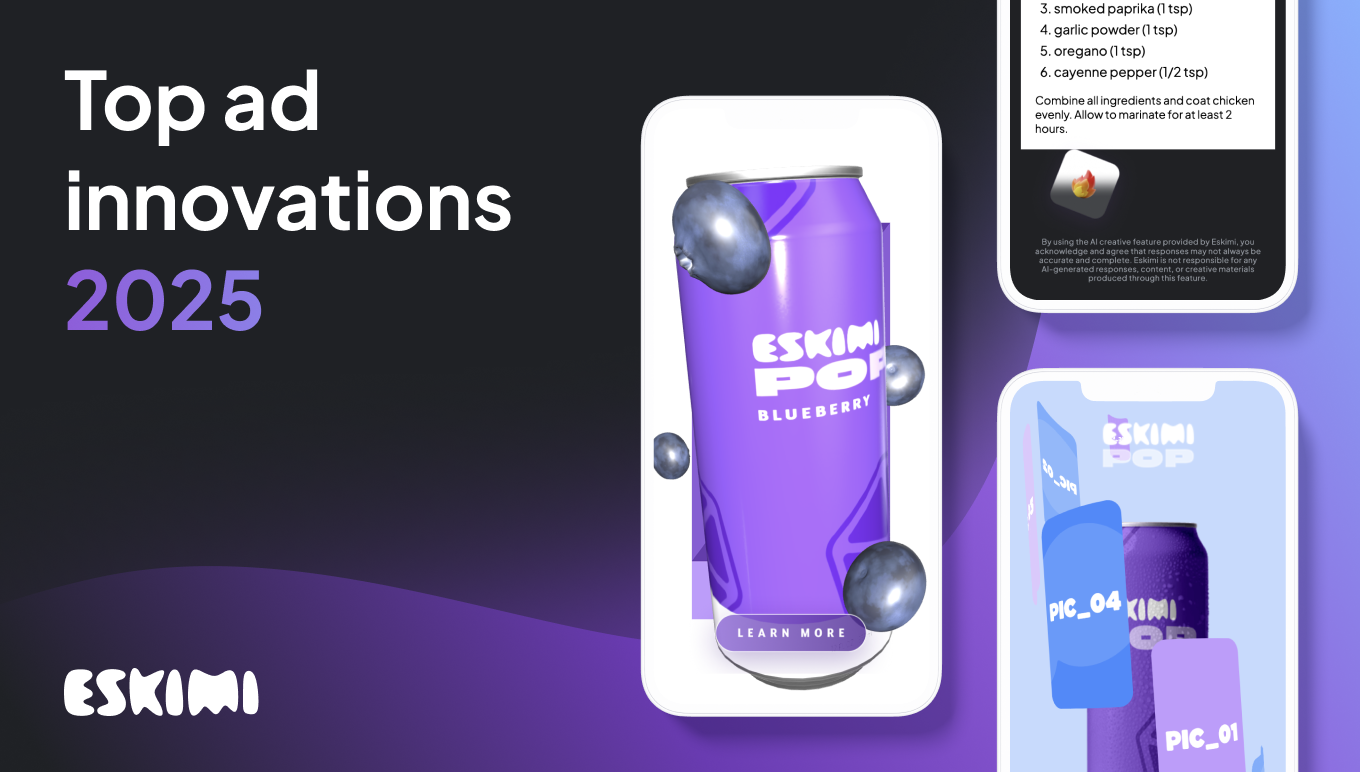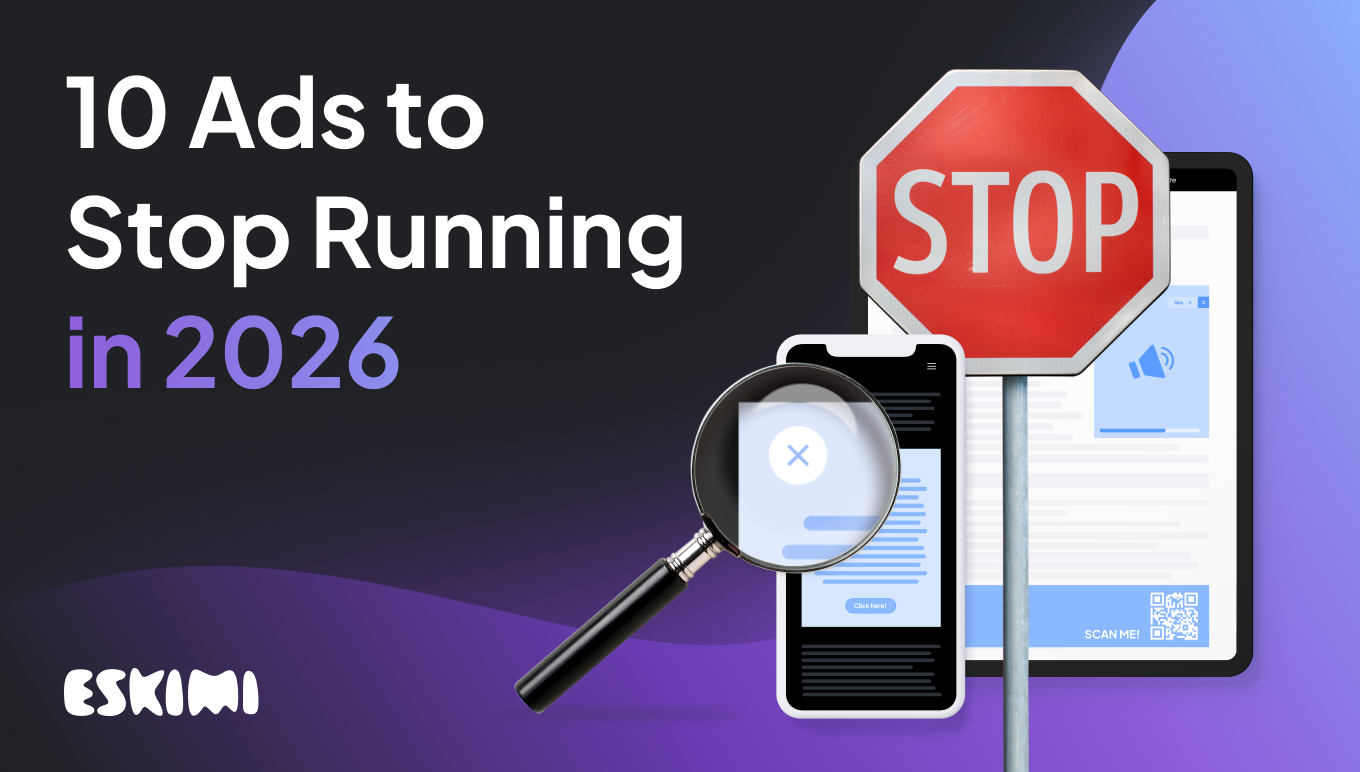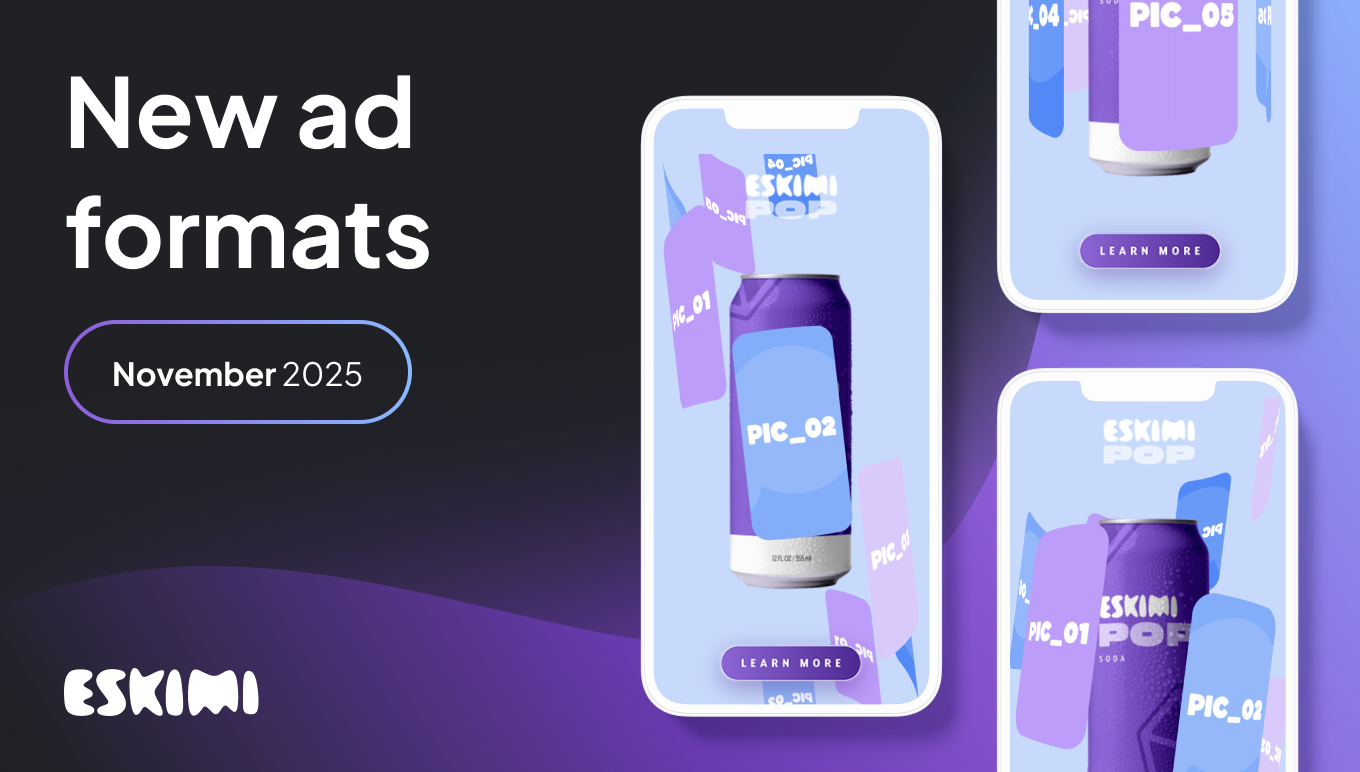9 Must-See Programmatic Advertising Examples For Inspiration

Learning from the best is a great way to improve your own choices.
Especially in such a dynamic industry as advertising, it can sometimes get challenging to predict the outcome of your ideas and overall efforts. Analyzing and drawing inspiration from what already works can be a rewarding practice that helps you become better at what you do and come up with decisions that bring desired results.
That’s why we’ve compiled this list of the best programmatic advertising examples for you to explore, learn, and… do even better.
What is programmatic advertising?
Programmatic advertising, as opposed to traditional and often manual digital advertising methods, is the use of automated technology for media buying.
The process of programmatic media buying involves the use of large data sets of data and automation, which enables brands and agencies to serve their ads to the right people at the right time, while for publishers, it’s an opportunity to sell more available ad slots and maximize revenue from ad placements.
Programmatic advertising types & how they work
The term programmatic advertising is often used interchangeably with RTB, or Real-time bidding. However, RTB is just one of the four programmatic advertising types, and it’s not entirely correct to use it when referring to programmatic overall.
RTB is an open auction where multiple advertisers compete to win ad slots on publishers’ websites for the best price. DSPs that advertisers use for programmatic bid on ad placements in real-time, the highest bid then wins the auction, and the ad is displayed.

Besides RTB, there are three other ways to launch programmatic ad campaigns:
- Private Marketplace (PMP): Private Marketplace environment is similar to RTB – it also works on an auction basis and the highest bid wins the ad slot. The difference between Open Auction and PMP is that PMPs are not really “open” – advertisers can access them only with an invitation from publishers.
- Programmatic Guaranteed: Programmatic Guaranteed allows advertisers to reserve ad inventory directly from publishers. Once they agree on the number of impressions that ads have to hit and a fixed price, the inventory is designated for a particular buyer and they are obliged to buy it.
- Preferred Deals: PD is similar to PG – advertisers and publishers agree on a fixed price, and advertisers get a priority to bid on available placements. The only difference is that with preferred deals, the advertiser is not obliged to buy the pre-agreed ad space. If denied, the deal automatically goes to open or private auctions.

Benefits of programmatic for advertisers
Automation in programmatic is one of the biggest advantages against traditional advertising methods as it helps to streamline the workflow and boost efficiency, leaving more time to focus on optimizing campaigns for the best results.
Besides this, there are several other benefits you should know if you’re planning to step into the programmatic advertising space:
- Better audience targeting: The variety of programmatic targeting features is among the top programmatic benefits that get highlighted a lot. Advertisers can precisely target their audiences based on a variety of criteria and reach their ideal customers with ease.
- Broader reach: With programmatic, advertisers can reach their target audiences on various websites and apps (depending on targeting combinations).
- Real-time data: Advertisers don’t need to wait until the end of the campaign to evaluate its performance, as the number of impressions, clicks, and websites your ads appear on can be tracked in real-time.
- Increased transparency: Running programmatic ads provides you with complete visibility over your campaigns, like exact sites where your ads appear, audiences that you reach, costs, etc., and valuable insights that let you plan better and improve.
- Flexible spending and budget management: With programmatic, advertisers can control how much they spend on their campaigns, reducing the chances of paying more than planned/they can afford.
- Variety of creative ad formats: Besides classic solutions like static banners, programmatic also comes with a variety of highly engaging ad formats, such as high impact ads, video ads, rich media, in-game, etc., that can help you create more impactful advertising campaigns and get better results.
Programmatic advertising examples to inspire your next campaign
When it comes to advertisers, the core features of programmatic advertising enable them to benefit from various engaging ad formats that they can run across different channels and platforms globally, and use advanced targeting combinations to reach exactly the people they want to reach.
Let’s go through some inspiring programmatic advertising examples that best reveal the possibilities of this digital advertising type, mainly focusing on different targeting options, environments, and ad types.
1. Hot Wheels matches the feeling of its audience with in-game ads
Hot Wheels, an American scale model car brand owned by Mattel, ran an advertising campaign to boost audience engagement after experiencing a shift in consumer behavior.
For this, they sought an innovative solution that would align with the brand essence and resonate with its audience, and found an ideal match in programmatic advertising.
Hot Wheels leveraged one of the quickest-growing programmatic advertising channels – in-game – to introduce its products to Hot Wheels' target audience in a creative, non-intrusive way. Instead of popping up on the screen or covering part of the content, their ads naturally blended into the game environment while users were playing.
Hot Wheels in-game campaign achieved an in-view rate of 99.58% (MOAT), which is 1,5 times more than the industry standard (60.40%), and hit 95.98% for fully on-screen rate (MOAT) – more than 41% higher than the benchmark for in-game ads (54.50%).
2. The Amanda Foundation uses programmatic to find the perfect match for pets
The Amanda Foundation, a non-profit organization dedicated to the welfare of cats and dogs, used programmatic advertising to connect their furry residents with the right adoptive families.
Being aware of the fact that people have different preferences for pets, including animal type (dog, cat), breed, and even energy levels, the Foundation sought to find a solution to reach the most suitable owner for each animal.

Using programmatic advertising and behavioral data, the Amanda Foundation was able to act as a matchmaker between the animals and their potential adopters. Advanced audience targeting enabled them to identify individuals with a keen interest in either cats or dogs, as well as specific “pet personalities” – for instance, older people might like a calmer, not that active pet, while the younger generation might prefer a pet that loves outdoor activities.
The idea to use actual user data to provide them with the most relevant option is one of the key strengths of programmatic and obviously worked well for the Foundation (and the pets). Every animal they featured was matched to a happy, loving home!
3. Yettel reaches niche audiences via CTV
As a telecommunications company, Yettel has a very broad audience. The industry the brand operates in is very dynamic, though, which makes it essential to always investigate new possibilities for reaching more specific segments of people on the channels never explored.
Therefore, Yettel used programmatic advertising to run its awareness video campaign on connected TV (CTV). CTV is another rapidly emerging programmatic channel (in the US alone, it is expected to reach 111 million out of 132 million households in 2023) that can help reach a growing audience of streamers.
Yettel’s debut on CTV was considered successful, as the brand video, which was 17 seconds long, achieved a 94.52% view-through rate. Furthermore, 78% of all served impressions resulted in completed views, highlighting the success of Yettel’s decisions.
4. IHG uses user data and precise targeting to win over new customers
One of the Intercontinental Hotel Group’s (IHG) programmatic campaigns is another very simple yet genius programmatic advertising example showing how combining collected user data with the right targeting solutions can help provide more value for potential customers while increasing brand transparency.
After analyzing how people book their hotels, IHG concluded that most travelers use third-party booking sites, thinking they are getting the best deal possible. However, knowing that booking directly can cost people 15-30% less, IHG decided to highlight this in its programmatic ads.

The solution that IHG came up with showcased to users the cost of booking directly with their hotels. Leveraging contextual targeting and demographic info, IHG could display ads personalized for specific users, making them more relevant to travelers' needs.
“By using advanced targeting capabilities through programmatic, we were able to find a broader range of people looking for accommodation and target them with our book direct message,” said Matt Luscombe, COO at Intercontinental Hotel Group.
Moreover, being straightforward and honest about pricing helped IHG earn its target audience's trust.
5. Haleon uses a story-driven video format to strengthen emotion
Haleon, a global consumer healthcare company, launched a seasonal advertising campaign to increase brand recall and awareness by utilizing the persuasive power of the VAST video. In particular, the campaign aimed to promote one of its nasal products for congestion relief.

As video advertising continues to captivate audiences and maintain its effectiveness, Haleon recognized the value of integrating programmatic strategies with this powerful medium to achieve desired results. By leveraging the power of storytelling, Haleon could effectively convey its product's benefits to the intended audience.
With this campaign, Haleon managed to successfully deliver the message to its ideal customers, surpassing planned KPIs. For instance, the expected number of views surpassed the initial projection by an impressive 58.38%, while the number of impressions exceeded the original plan by 44.85%.
Haleon’s combination of VAST video and programmatic advertising resulted in an effective and engaging campaign, achieving excellent outcomes for the brand.
6. The Economist tailors ads to specific interests to get readers on the site
News outlet The Economist made great use of programmatic display advertising, creating a series of minimalistic ads featuring copies aimed at highlighting the benefits of reading The Economist.

The Economist team knew that they were missing out on the younger audience of potential readers since they were not truly aware of the news outlet’s role as the voice for progressive liberalism.
The goal of this campaign was to attract these curious readers to The Economist site. For this, the team used display ads to reach 650,000 people and persuade them to subscribe to the magazine.
The Economist’s ads spoke to different user segments that were created based on current subscribers’ behavior on the site, including topics like finance, politics, economics, good deeds, technology, and similar. Then, The Economist used contextual targeting to place ads in the right contexts to reach the right people in the right places.
The campaign turned out to be successful, achieving 50% of The Economist's target of 650,000 subscribers in 9 days.
7. ABC Extra Stout reaches its target demographics where they are
ABC Extra Stout, one of Heineken’s owned beer brands, tapped into programmatic in-game advertising to strengthen its efforts to reshape the public perception of its product.
Being a stout beer, ABC Extra Stout has always been associated with the older demographics. After going through a rebranding, ABC sought to establish itself as a beverage for the new generation of buyers, which led them to focus its targeting on over 18-year-olds.

ABC’s programmatic advertising strategy focused on mobile gaming environments where their target audience frequently spends a significant amount of time. By choosing the right channel and targeting options, ABC was able to achieve its goal.
Remarkably, the majority of the audience that the brand reached with its in-game campaign – 68% – consisted of players between the ages of 18 and 34, demonstrating the effectiveness of this approach.
8. Spotify delivers personalized ads to improve engagement rates and ROI
Spotify, one of the most popular music streaming platforms, used programmatic advertising to deliver personalized ads to its users while improving its return on investment.
By analyzing user data on music preferences and listening habits, including different genres, frequency, and time of the day, Spotify could serve highly relevant ads that resonated with individual music streamers. So, for example, if the user was listening to rock music, it might have shown related events in their area.
Matching people’s interests with their music tastes and habits proved to be a highly effective advertising strategy for Spotify.
Its programmatic ad campaign helped the brand achieve an engagement rate that was 2.5 times higher than the industry average, and Spotify also noticed a 25% increase in ad recall.
Additionally, the company reduced its cost per acquisition by 20%, which resulted in higher revenue and profitability.
9. McDonald’s drives foot traffic to their physical locations
McDonald’s, a well-known fast food chain, leveraged programmatic advertising to deliver personalized ads to its target audience and drive foot traffic to its restaurants.
For its recent witty “Raise Your Arches” campaign, McDonald’s used DCO (dynamic creative optimization) and location targeting to deliver ads tailored to users’ current situation, e.g., time of day (daypart targeting) and specific location. This way, McDonald’s could serve ads focused on users’ preferences and habits, making its advertising more impactful.
McDonald’s programmatic advertising campaign achieved remarkable outcomes. The restaurant chain increased its foot traffic by 7.5% and recorded a 4.5% rise in sales at its physical locations.
Next on the list – your programmatic ad campaign?
Looking at the examples, you can better understand how programmatic advertising works and what advantages it can bring to your brand. Typically, it’s being used to drive engagement, increase brand awareness, and boost conversions by leveraging user data, which helps to improve the relevance of ads.
As technology continues to evolve, we can expect programmatic advertising to become even more sophisticated and play an increasingly vital role in shaping the future of digital marketing.
Are you thinking of launching a programmatic campaign? Contact the Eskimi team or book a demo for a smooth start.
Level Up Your Advertising with Eskimi
- Reach 96% of Open Web
- 2,500+ Targeting Options
- 100% Managed or Self-Service
- In-House Creative Studio Team
- Display, Video, In-Game & CTV
- #1 Rated DSP on G2





